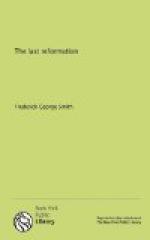Of the uncircumcised Gentiles it is said, “The holy city shall they tread under foot forty and two months.” This signifies the great apostasy that overspread the earth, defiling and perverting the true worship of God. The burden of this series, however, is not to describe the foreign element thus introduced, but to set forth in greater fulness the fact that during the same time that the idolatrous multitude of Gentiles trod down the holy city God preserved his own people. The temple still remained, and it had devout worshipers; the two witnesses still prophesied, although clothed in sackcloth, an emblem of melancholy and mourning. While the visions of the Revelator describe particularly the power of apostasy and iniquity reigning during the Dark Ages, they do not fail to give us the assurance that at the same time God had a people whose names were written in the book of life (chap. 13:8)—“saints” (chap. 13;10). And these were made the object of the most violent persecution (chap. 13:17; 17:6).
It is rather difficult to trace the true work of God during those times; for his “saints” were either ignored by the professed multitude or else regarded as heretics. But there existed in different countries bands of people who opposed the doctrines and ecclesiastical tyranny of Rome and who claimed adherence to the simple, primitive faith of Christ as expressed in the gospel. Among these were the Cathari, Lombards, Albigenses, Waldenses, and Vaudois. I will not say that all these so-called heretics are to be regarded as the true people of God, but from the few records that we have of them, derived chiefly from their enemies, it seems clear that there were among them many who were truly “saints” and who clung tenaciously to the true faith of Christ. God’s Word and Spirit were therefore prophesying, although in an unnatural condition, symbolized by the sackcloth state of the witnesses. We must also remember that even among the Catholic party were to be found noble persons whose hearts were true to whatever truth they had and whose emotions and aspirations at times broke over the bounds of traditional theology and gave expression to sentiments Scriptural and sublime.




